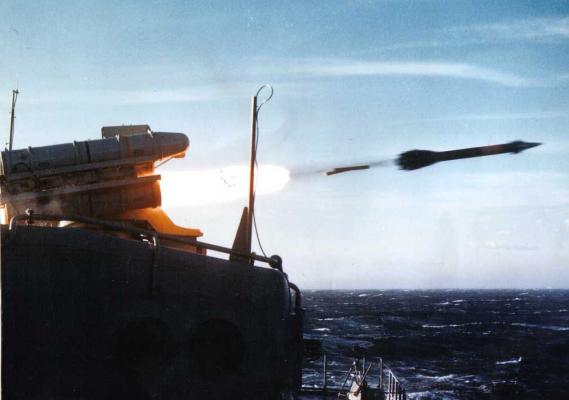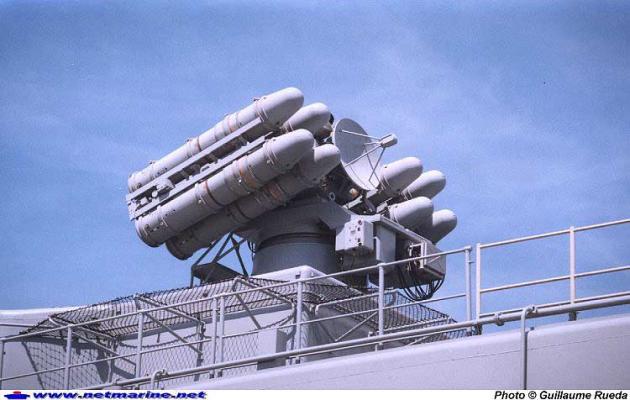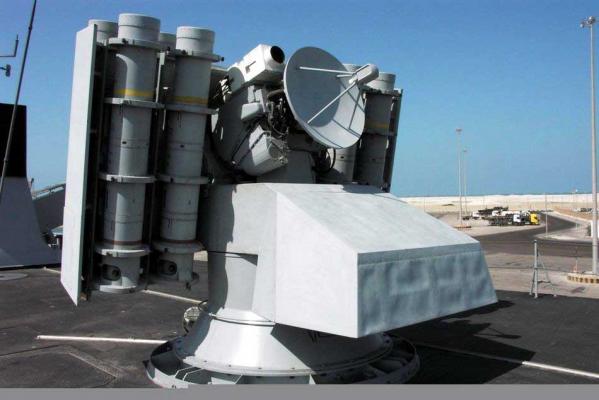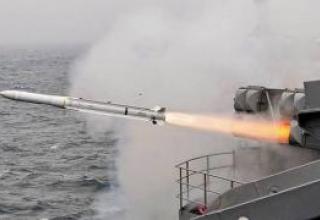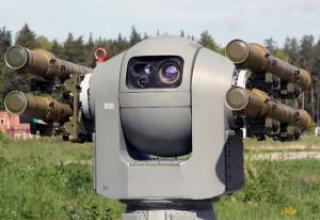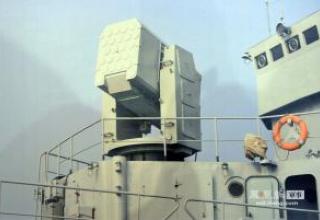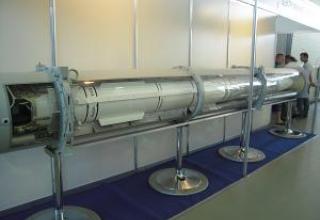Crotale Naval is a short-range anti-aircraft missile system designed to defend surface ships with displacement of more than 2000 tons from aircraft and low-flying anti-ship missiles in the near air defense zone. Works on creation of ship anti-aircraft missile system (SAM) Crotale Naval were started by Thomson-CSF in 1974. As a prototype was used SAM system of ground forces Crotale.
Tests were conducted in 1978, and in 1979-1980 it began to enter service with the French Navy under the designation of Crotale Naval-8B (base) .
Experience from the military conflicts of the 80s showed that low-flying anti-ship cruise missiles are a serious threat to surface ships, and the means of repelling air attacks in the Navy ships are not effective enough. Based on this experience, the French Navy contracted Thompson-CSF to upgrade the Crotale Naval SAMs. The objective of this work was to improve the complex in order to enhance its capabilities to fight supersonic anti-ship missiles flying at altitudes of 3-5m at speeds up to 2M. The upgraded complex was designated the Crotale Naval-8S.
Further work on the improvement of the complex continued. A variant of modular configuration, which received the designation 8M, and its compact four-contner analogue - 4M was developed. At present, a lightweight version of the Crotale Naval-8MS is in production.
Composition:
The Crotale Naval Model 8S complex includes the R400N anti-aircraft guided missile (SAM) and a launcher. During the development of the marine version of the complex in the missile was added to the traction delay device of the SAM, expanded computer capabilities to account for the ship's rocking, the number of missiles on the PU brought to 8, but the SAM itself and the transport and launch container have not undergone significant changes as compared with the land analogues.
The Crotale Naval-8S complex hits enemy missiles flying at a speed of 450-600 m/s in the altitude range of 4-4000 m. The minimum intercept radius of low-flying missiles with EPR is about 0.1 square meters, the maximum - 6.5 km. Range of fire on maneuvering aircraft at a speed of 1.2M increased to 10 km, on helicopters or non-maneuvering aircraft - up to 13 km. The missile guidance system provides interception of aircraft maneuvering with overloads in two units at a range of 8.5 km. The improved homing system on the final section of the trajectory allows ZUR "Crotale Naval" to intercept PCR, maneuvering with overloads of 5-10 units.
The combat unit - shrapnel-phugasnaya, for reduction of probability of false operation on reflections from a water surface is equipped by the electromagnetic noncontact fuse which is platooned on distance 300м to the purpose. The radius of engagement of a typical target is about 8m.
The 8S launcher has two packs of rails with 4 SSDs each. The mass of the PU with missiles - 6.5 t, the radius of sweeping - 2.5m. Guidance angles in the vertical plane - from -15 ° to + 70 °. Launching equipment includes a turret-type launcher and a magazine for storing 18 missiles. Recharging is carried out manually by fixing the PU containers fed from the magazine by a pneumatic device. The same containers are used to store the missiles.
The PRBV-51 tracking radar, a TV camera and SEID target tracking system (developed by SAT), as well as the IR system used to introduce the missile after launch into the radar beam are installed directly on the booster. The position of the radar antenna and the launcher is changed synchronously.
The PRBV-51 tracking radar has a range of about 18 km. Its antenna is located on the launcher and is stabilized in two planes. The missile can be launched in 6 seconds after the target is handed over to the escort. The air defense equipment allows to point up to two missiles simultaneously starting at 3s intervals.
SEID system is specially designed to escort low-flying anti-ship missiles in order to eliminate the interference caused by the reflection of radar signals from the sea surface when shooting at low-flying targets. SEID system operates in the range of 8-12 µm and in favorable weather conditions provides a target detection range of 18-20 km. The principle of operation is the simultaneous tracking of the target and the Crotale SUR using a passive channel. When hovering, the capture of the launched SAM takes place 2 seconds later. During this time, the missile passes a distance of 500 m. and this interval of the trajectory control of the missile is carried out by another infrared system located on the PU, which carries out the conversion of the LRS either in the area of SEID system or in the beam of the radar.
The target designation data is issued from the ship's combat information and control system (BIUS) or independently from the detection radar. After the missile is detected, the ship's radar begins its tracking (see radar guidance scheme). If the target is lower than 50 m, the SEID infrared passive tracking unit with an accuracy of 0.1 m stealth is automatically activated instead of the radar. To improve the tracking accuracy of the anti-aircraft missile, an IR tracer is installed in a beam of 20 m steeped in azimuth and 30 m steeped in the angle of position in its tail part (see the guidance diagram in IR mode). During the interception of the computer, the fire control system calculates the necessary corrections, which are transmitted via the radio channel to the SAM.
The complex in the 8S configuration is made as a single module with the total mass of more than 10 tons, which limits the possibility of installing it on ships of small displacement.
In Crotale Naval-8M SAMs the tracking systems and the launcher are separated. The use of the modular principle of air defense system construction allowed to reduce its mass up to 7.5 tons (mass of projectile PU - 4.2 tons, without missiles - 3 tons). The projectile launcher in configuration 4M has a mass of 2.5 t. Since the centre of gravity of the booster was located near the intersection of the booster's axes of rotation, the guidance speed was increased. The angle of pointing of the EE in the vertical plane is from -15° to + 80°.
The complex ensures the interception of the anti-ship missile with 0.8 probability at its following parameters: effective scattering surface up to 1 m2, flight speed 0.9-1.2M, altitude 50-3500m, range 0.7-8.5 km. When firing a volley of two missiles, the probability of hitting a low-flying target increases to 0.96.
Characteristics:
| Range of fire, km | 0.5-13 |
| Missiles flight speed | 2.6М |
| The length of the rocket, mm | 2900 |
| The diameter of the rocket body, mm | 150 |
| Wingspan, mm | 550 |
| Start weight , kg | 80 |
| Weight of combat unit, kg | 15 |
| The reaction time of the complex, sec | 6 |
Testing:
The first combat use of the S-200 SAM system took place in 1982 in Syria, where at a distance of 190 km the E-2C "Hawkeye" DRLO was shot down, after which the American aircraft carrier fleet withdrew from the Lebanese coast. The Libyan S-200 complexes took part in repulsing an attack by American FB-111 bombers and possibly shot down one bomber.
On the basis of the 5B28 anti-aircraft missile of the S-200B complex a hypersonic flying laboratory "Cold" has been created to test hypersonic direct-flow air jet engines. The choice of this missile was based on the fact that the parameters of its flight path were close to those required for flight tests of the Hyper-Sonic Propulsion System. It was also considered important that the missile had been decommissioned and its cost was low. The missile's combat unit was replaced by the head compartments of the GLL "Kholod", which housed the flight control system, a liquid hydrogen tank with displacement system, a hydrogen flow control system with measuring devices and, finally, the experimental HPVRD E-57 of axially symmetric configuration.
Sources:
- Б.И.Родионов, Н.Н.Новичков "Крылатые ракеты в морском бою", -М.: Военное издательство, 1987.-214с.
- Crotale - New generaion of SHORADS Naval Application
- Rampe de missiles Crotale sur la frйgate Tourville
